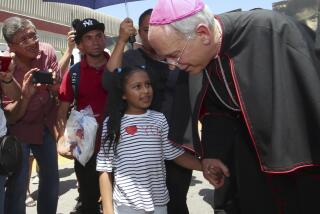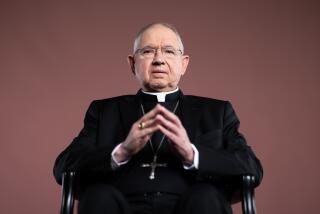Bishop Brom Celebrates Open-Air Mass at Migrant Camp
The immigrant workers and their families gathered in a makeshift chapel amid a willow thicket early Saturday to hear their new bishop, who made an effort to deliver his message in their language. His words were heard above the rush of a nearby stream, now swollen from recent rains.
“Jesus was a worker too; he understood what it was to be tired from his labor,” Bishop Robert H. Brom told the assembled gathering, mostly field hands from Mexico who can’t afford the area’s high housing prices and live in crude dwellings amid the surrounding chaparral.
“Jesus was interested in the poor, and in all people who suffered,” Brom told listeners in the chilly morning air redolent with the aroma of sage and willow. “Brothers, I’m here to tell you that the church of God loves you and wants to help you.”
It was a deliberate message of involvement and concern from the man who is in line to become the Bishop of the Roman Catholic Diocese of San Diego, making him the most influential religious leader in the San Diego area. Bishop Brom, formerly Bishop of Duluth, Minn., is slated to succeed Bishop Leo T. Maher in July, when Maher turns 75, the Church’s mandatory retirement age. Maher will step down after two decades as the pastoral guide for the area’s Catholics.
It seems clear from Brom’s visit Saturday and from his comments that Latino and immigrant-laborer issues are likely to be at the forefront of his agenda, signaling a reversal of what many view as Bishop Maher’s more ambivalent attitude toward such matters. Later Saturday, the area’s Latino community was to receive Brom officially during a ceremony at St. Joseph’s Cathedral in downtown San Diego.
For Brom, a 51-year-old, seemingly mild-mannered Midwesterner who was reared in rural Wisconsin and Minnesota, the Mass he celebrated in the brush and his subsequent visit to one of the area’s largest migrant encampments appeared to be an eye-opener. Never before, he said, had he seen such primitive living conditions, particularly the striking contrast between the poverty of the workers and the wealth of the surrounding community. Such scenes have become commonplace in the San Diego area, although they are still jarring, particularly to newcomers.
“The disparity is remarkable,” Brom said afterward as he stood amid the shanties of plastic, scrap wood and cardboard that mark McGonigle Canyon in the Rancho Penasquitos area of San Diego. “I’m surprised. Who could explain this? You have to see it. You have to walk through it, to enter into it.”
Several hundred workers reside in the shacks, which have no running water or electricity. A raging fire last year destroyed many of the dwellings, forcing the workers to rebuild. Heavy rains have created a muddy quagmire.
Meantime, there has been some talk of evicting the migrants, who are squatters on private land slated for future redevelopment. Similar encampments and predicaments can be found throughout northern San Diego County.
Since he was appointed coadjutor, or heir-apparent, last May, Brom has stressed his interest in reaching out to the region’s large population of Latinos, particularly Mexican-Americans and Mexican nationals who reside here. He estimates that 40-45 % of the area’s more than 600,000 Catholics are Latinos. The proximity of the U.S.-Mexico border contributes to a continual upward trend in the Latino population.
‘We’re in dialogue right now, trying to decide how the diocese might better respond to the needs of the Hispanic community, to better include (them),” noted Brom, who has been meeting in recent weeks with representatives from throughout the diocese.
Among those who work with the immigrant and Latino community, there is considerable hope that the new bishop will emphasize those issues in the way that Archbishop Roger Mahony has done in Los Angeles. They viewed his visits Saturday as a hopeful sign.
“For him to come and meet with the people shows real character,” said Gina Velasquez, a volunteer from nearby Our Lady of Mt. Carmel Church who has long worked with migrant laborers in the fields. Father Frank Fawcett, pastor of Mt. Carmel, invited the bishop to the outdoor Mass, which has been a weekly event for two years.
Last fall, Brom spent a month studying Spanish in Mexico, a skill that he will have ample opportunity to use during his time in San Diego, one of the world’s great migratory corridors and the principal entry point for hundreds of Latin Americans daily seeking to enter the United States, with and without documents. His Spanish is still embryonic, he acknowledges, but the migrants gathered Saturday clearly appreciated his effort.
“To accomplish the mission of a priest and bishop, you have to enter into where people are, by using language, by your presence,” Brom said, explaining his decision to learn Spanish. “I knew I could never do that with a translator; you come off as distant.”
Being distant is clearly not the style preferred by Brom, who was known in Duluth for his unpretentious ways, administrative skills and his ability to inspire others by relating Christian doctrine to everyday situations. His method is hands-on.
After Mass, still donning his green bishop’s robes, he personally greeted most everyone in the crowd, liberally offering blessings to men, women and children. Later he spoke repeatedly of the importance of seeking change and improvement through grass-roots contacts with migrant workers and other underprivileged people.
“Jesus became flesh; he entered the world to change it from within,” Brom said, reciting a basic principle of Christianity. “The Word would never have become flesh if it hadn’t come down from Heaven and gotten down and dirty.”
He routinely uses words such as “liberation” and “solidarity,” which often have political connotations, particularly in Latin America. But Brom, like the Church hierarchy in Rome, warns against “politicization” of the Gospel.
For Brom, the visit also brought back his rural, working-class upbringing, when he himself picked strawberries, beans and other crops. “I know what it is to work the way these people do,” he said. “It gave me a feeling of living close to the earth.”
After one visit, he wasn’t prepared to offer solutions to the dilemma of migrant housing. A first step, he concluded, would be to “sensitize” people to the reality of the problem.
For those in the camps, who remain wary of outsiders, the visit of such a high-ranking church official was welcomed. “We come from so far away, and we are so different here, that it makes us happy that someone like that would take the time to be with us,” noted Jacinto Cortez, a 33-year-old Mexican laborer.
More to Read
Sign up for Essential California
The most important California stories and recommendations in your inbox every morning.
You may occasionally receive promotional content from the Los Angeles Times.










